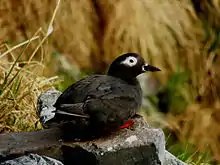Cepphus
Cepphus is a genus of seabirds in the auk family also referred to as true guillemots or, in North America, simply as guillemots. The genus name Cepphus is from Ancient Greek kepphos, a pale waterbird mentioned by Greek authors including Aristotle.[1] The English word "guillemot" is from French guillemot probably derived from Guillaume, "William".[2] "Murre" is of uncertain origins, but may imitate the call of the common guillemot.[3]
| Cepphus | |
|---|---|
 | |
| Black guillemot ( Cepphus grylle) | |
| Scientific classification | |
| Kingdom: | Animalia |
| Phylum: | Chordata |
| Class: | Aves |
| Order: | Charadriiformes |
| Family: | Alcidae |
| Genus: | Cepphus Pallas, 1769 |
| Species | |
|
C. grylle | |
These are medium-sized birds with mainly black plumage in the breeding season, thin dark bills and red legs and feet. Two species have white wing patches, the third has white facial “spectacles”. They are much paler in winter plumage, mottled above and white below.
The breeding habitat is rocky shores and islands on the coasts of the northern Atlantic and Pacific Oceans. They usually lay their eggs in rocky sites near water.
These birds may overwinter in their breeding areas, moving to open waters if necessary, but usually not migrating very far south.
They dive for food from the surface, swimming underwater. They mainly eat fish and crustaceans, also some molluscs, insects and plant material.
The species are:
| Image | Scientific name | Common Name | Distribution |
|---|---|---|---|
 | Cepphus grylle | Black guillemot or Tystie | Circumpolar: Arctic coasts, North Atlantic, Alaska |
 | Cepphus columba | Pigeon guillemot | Kuril Islands and the Kamchatka Peninsula in Siberia to coasts in western North America from Alaska to California. |
 | Cepphus carbo | Spectacled guillemot | Sea of Okhotsk and the Kuril Islands in Russia and on the northern island of Hokkaidō in Japan |
There are also fossil forms
- Cepphus olsoni Howard, 1982 (San Luis Rey River Late Miocene - Early Pliocene of W USA)
- Cepphus storeri Harrison, 1977 (Red Crag of Suffolk Late Miocene - England
- Cepphus cf. columba (Lawrence Canyon Early Pliocene of W USA)
- Cepphus cf. grylle (San Diego Late Pliocene, W USA)
The latter two resemble the extant species, but because of the considerable distance in time or space from their current occurrence may represent distinct species.
References
- Jobling, James A (2010). The Helm Dictionary of Scientific Bird Names. London: Christopher Helm. p. 96. ISBN 978-1-4081-2501-4.
- "Guillemot". Oxford English Dictionary (Online ed.). Oxford University Press. (Subscription or participating institution membership required.)
- "Murre". Oxford English Dictionary (Online ed.). Oxford University Press. (Subscription or participating institution membership required.)
| Wikimedia Commons has media related to Cepphus. |